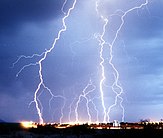Plasma (physics)
  |
|
  |
|
| Top row: Lightning, Neon lights or electrical sparks are everyday examples of plasma in Nature. Bottom row: A plasma globe, illustrating some of the more complex plasma phenomena, including filamentation. The second image is of a plasma trail from Space Shuttle Atlantis during re-entry into Earth's atmosphere, as seen from the International Space Station. |
Plasma, from Greek πλάσμα, meaning "moldable substance" or "jelly" is one of the four fundamental states of matter, the others being solid, liquid, and gas. Yet unlike these three states of matter, plasma does not naturally exist on the Earth, and can only be artificially generated from neutral gases. The term was first introduced by chemist Irving Langmuir in the 1920s.
Plasma and ionised gases have unique properties and display behaviors unlike those of the other states, though the true technical transition between the two is mostly a matter of nomenclature and subject to interpretation. It can simply be considered as a gaseous mixture of negatively charged electrons and highly charged positive ions, being created by heating a gas or by subjecting gas to a strong electromagnetic field. However, true plasma production is from the distinct separation of these ions and electrons that produces an electric field, which in turn, produces electric currents and magnetic fields.
Based on the surrounding environmental temperature and density either partially ionised or fully ionised forms of plasma may be produced. Partially ionised plasma is popularly understood, for example, as bright neon signs or lightning storms, while more fully ionised plasma is associated with the interior of the Sun, the solar corona, and stars.
The positive charge in ions is achieved by stripping away electrons from atomic nuclei. The number of electrons removed is related to either the increase in temperature or the local density of other ionised matter. This also can be accompanied by the dissociation of molecular bonds, though this fundamental process is distinctly different from chemical processes of ion interactions in liquids or the behaviour of ions existing in metals. A significant number of highly charged particles together make plasma electrically conductive so that it responds strongly to electromagnetic fields, and this property can be usefully employed in many modern technological devices, such as, plasma televisions or plasma etching.
...
Wikipedia
